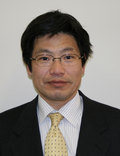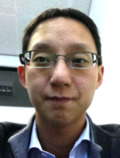Awards
Best Paper Award
O2-3 Learning Based Super Resolution Using Identity and Spatial Information for Surveillance Camera Facial Images
Ka Pik Lee, Takashi Shibata and Atsushi Sato
Excellent Paper Award
O1-1 Gaussian-Polynomial Kernel for Real-time Tracking by Detection Method
Laksono Kurnianggoro, Joko Hariyono, Hyundeok Kang and Kang-Hyun Jo
O5-2 Human Wearable Attribute Recognition using Decomposition of Thermal Infrared Images
Brahmastro Kresnaraman, Yasutomo Kawanishi, Daisuke Deguchi, Tomokazu Takahashi, Yoshito Mekada, Ichiro Ide and Hiroshi Murase
Special Talks
Keynote
Title: Media understanding technologies for safer city

Speaker: Keiji Yamada (NEC Laboratories Singapore)
Head of NEC Laboratories Singapore
Senior Vice President, NEC Asia Pacific Pte. Ltd.
Abstract
In this presentation, the speaker talks about applications of media understanding technologies to solve social problems caused by “urbanization”. The 21st century is called as the century of “urbanization”. By 2050, around 70 percent of the world population will live in urban areas. This will cause many problems in cities such as more crimes, severer traffic congestions, higher social security costs, and shortage of city infrastructures. The speaker studies applications of media understanding technologies to address these issues. In this presentation, he will introduce the concept of “safer city” which will be free from “urbanization” problems. And he will show some examples of the solution ideas based on media understanding technologies that he has been examining in the real scences.
Invited Talks
Title: Photometric 3D reconstruction

Speaker: Yasuyuki Matsushita (Osaka University)
Yasuyuki Matsushita received his B.S., M.S. and Ph.D. degrees in EECS from the University of Tokyo in 1998, 2000, and 2003, respectively. From April 2003 to March 2015, he was with Visual Computing group at Microsoft Research Asia. In April 2015, he joined Osaka University as a professor. His research area includes computer vision, machine learning and optimization. He is on the editorial board of IEEE Transactions on Pattern Analysis and Machine Intelligence (TPAMI), International Journal of Computer Vision (IJCV), IPSJ Journal of Computer Vision and Applications (CVA), The Visual Computer Journal, and Encyclopedia of Computer Vision. He served/is serving as a Program Co-Chair of PSIVT 2010, 3DIMPVT 2011, ACCV 2012, ICCV 2017, and a General Co-Chair for ACCV 2014. He is a senior member of IEEE.
Abstract
Reconstructing the 3D shape of real-world objects is an important step for various computer vision tasks, such as robot navigation, object recognition, and scene understandings. Photometric approaches to image-based 3D reconstruction exploit shading variations observed in the scene for recovering highly-detailed 3D shapes. This talk will introduce recent advances in photometric 3D reconstruction, where robustness against unmodeled observations such as specular reflections and shadows is enhanced based on modern convex optimization techniques.
Title: Randomized Decision Forests for Pose Estimation

Speaker: Tae-Kyun Kim (Imperial College London)
T-K Kim is an Assistant Professor and leader of Computer Vision and Learning Lab at Imperial College London, UK, since Nov 2010. He obtained his PhD from Univ. of Cambridge in 2008 and Junior Research Fellowship (governing body) of Sidney Sussex College, Univ. of Cambridge for 2007-2010. His research interests primarily lie in decision forests (tree-structure classifiers) and linear methods for: articulated hand pose estimation, face analysis and recognition by image sets and videos, 6D object pose estimation, active robot vision, activity recognition, object detection/tracking, etc. which lead to novel active and interactive vision. He has co-authored over 40 academic papers in top-tier conferences and journals in the field, his co-authored algorithm for face image retrieval is an international standard of MPEG-7 ISO/IEC. He is co-recipient of the KUKA best service robotics paper award at ICRA 2014, and general chair of CVPR15 workshop on HANDS and ICCV15 workshop on Object Pose.
Abstract
Randomised Decision Forests is an emerging technique in the fields. A hierarchical structure yields many short paths, accelerating evaluation time, while feature randomisation promotes good generalisation to unseen data. In this talk, we see applications of Randomised Decision Forests and tree-structured methods with comparisons and insights. The talk focuses on articulated hand pose estimation, and face recognition/landmarking. Hand and face are highly articulated and deformable objects, playing a key role for novel man-machine interfaces. Estimating their 3D postures, or regressing locations of joints/fiducial points is highly challenging. We have tackled the problems by various novel ideas on top of the cutting-edge techniques. We conclude the talk with some future directions including 6D object pose estimation and active interactive object recognition. More information is found at http://www.iis.ee.ic.ac.uk/ComputerVision.
Detailed Presentation Schedule
February 17
Oral Session I (14:00-15:30): Image Applications
Chair: Jong-Il Park, Yoshinori Kuno
- O1-1 Gaussian-Polynomial Kernel for Real-time Tracking by Detection Method
Laksono Kurnianggoro, Joko Hariyono, Hyundeok Kang and Kang-Hyun Jo
- O1-2 Real-Time Human Body Tracking with Estimation of Physical Size
Tsuyoshi Migita, Kohei Hase and Takeshi Shakunaga
- O1-3 Face Tracking against Extreme Head Poses using Manifold Embedding-Active Shape Model
In-Ho Choi and Yong-Guk Kim
- O1-4 Visual speech recognition using optical and depth image features
Satoshi Tamura, Takuya Kawasaki, Koichi Miyazaki, Kazuto Ukai and Satoru Hayamizu
- O1-5 Basic Study on Person Re-identification with Dense Trajectories in the Occlusion Case
Takaaki Imanari, Yudai Miyashita, Hirokatsu Kataoka and Akio Nakamura
- O1-6 Human Body Segmentation Using Texture Aware Grab-cut and Statistical Shape Models
Esmaeil Pourjam, Yasutomo Kawanishi, Ichiro Ide, Daisuke Deguchi and Hiroshi Murase
Oral Session II (15:45-16:45): Object tracking
Chair: Kang-Hyun Jo, Yoshimitsu Aoki
- O2-1 Learning a No-Reference Quality Metric for Single-Image Super-Resolutoin
Chao Ma, Chih-Yuan Yang, Xiaokang Yang and Ming-Hsuan Yang
- O2-2 Chromaticity Analysis of Specular Reflection of Woven Fabrics from High-Resolution Multi-band HDR Images
Shiro Tanaka, Yoshiyuki Sakaguchi and Hiromi T. Tanaka
- O2-3 Learning Based Super Resolution Using Identity and Spatial Information for Surveillance Camera Facial Images
Ka Pik Lee, Takashi Shibata and Atsushi Sato
- O2-4 Background Subtraction Algorithm based on Codebook using Visual Difference
Hyung-Jae Son, Jeung-Chul Park, Jeong-Sun Park and Beom-Ryeol Lee
February 18
Oral Session III (10:15-11:45): Computer Vision
Chair: Sangkeun Lee, Hideo Saito
- O3-1 A Comparison of Two Approaches for Multi-Volume Super Resolution in MRI
Yutaro Iwamoto, Xian-Hua Han, Akihiko Shiino and Yen-Wei Chen
- O3-2 Computer-Aided Colorectal Tumor Classification in NBI Endoscopy Using CNN Features
Toru Tamaki, Shoji Sonoyama, Tsubasa Hirakawa, Bisser Raytchev, Kazufumi Kaneda, Tetsushi Koide, Shigeto Yoshida, Hiroshi Mieno and Shinji Tanaka
- O3-3 Automatic Screening system for scoliosis utilizing moire pattern
Ran Choi, Yoshimitsu Aoki, Kota Watanabe, Masaya Nakamura, Morio Matsumoto, Nobuyuki Fujita, Yuji Ogura, Takashi Tsuji, Kanichiro Wata, Toshiaki Kotani, Masashi Miyazaki, Hideki Shigematsu, Satoru Demura, Masamichi Takahashi and Katsumi Abe
- O3-4 Multiple Kernel Learning for Text Detection in Natural Scene Images
Wenlong Li and Takio Kurita
- O3-5 Camera Pose Estimation Based on Keypoints Matching with Pre-Captured Set of Real Images
Kei Obata and Hideo Saito
- O3-6 Simple Multi-block based tracking with CSK tracker
Guisik Kim, Soowoong Jeong and Sangkeun Lee
Poster Session I (13:00-14:30)
- P1-1 Interior point method with ADMM for MRF optimization
Tsuyoshi Harada, Toru Tamaki, Takio Kurita, Bisser Raytchev and Kazufumi Kaneda
- P1-2 Reading Dot-matrix Text via Variation Model Based Learning
Koshi Suzuki, Wataru Ohyama, Tetsushi Wakabayashi and Fumitaka Kimura
- P1-3 Recognition of Low Resolution Telops in Arabic News Broadcasting
Seiya Iwata, Wataru Ohyama, Tetsushi Wakabayashi and Fumitaka Kimura
- P1-4 Image-based Automatic high-precision alignment for Heliostat using attached camera
Shunsuke Asai, Wataru Ohyama, Tetsushi Wakabayashi, Fumitaka Kimura, Kazuya Sawayama and Takeshi Matsukawa
- P1-5 Head Pose Estimation using Histograms and Random Forest
Sung-Hee Mun, Chil-Woo Lee and Jae-Wan Park
- P1-6 Model Based 3D Gaze Estimation from a Monocular Camera
Kimimasa Tamura and Yoshimitsu Aoki
- P1-7 Color Grading Framework for Digital Cinema Post-Production
Ji-Hoon Yoo, Bong-Seok Choi, Shibudas Kattakkalil Subhashdas and Yeong-Ho Ha
- P1-8 Make and Model Recognition of Cars Based on Kernel Learning Using Multi-Scale SIFT
Shubhra Aich, Hao Xu and Chil-Woo Lee
- P1-9 Bundler for Fisheye Camera Models
Naoyuki Maeda, Amandine Paulo-Guieu, Ngo Thanh Trung, Hideaki Uchiyama, Hajime Nagahara and Rin-ichiro Taniguchi
- P1-10 Phase Reliability Evaluation Method using Correlation Between Amplitude and Object Image
Norikatsu Sumi, Koosuke Hattori, Ryo Taguchi, Masahiro Hoguro, Taizo Umezaki and Hideyoshi Horimai
- P1-11 Multi-class Eigen Tempalate Matching for Shogi Robot System
Gou Koutaki, Koshiro Yata, Makoto Meno and Keiichi Uchimura
- P1-12 Connecting Symbol Segmentation for Mathematical OCR by Thinning-based Segmentation Point Detection
Ryuhei Kawaguchi, Wataru Ohyama, Tetsushi Wakabayashi, Fumitaka Kimura and Yasuji Miyake
- P1-13 New feature extraction method for facial emotion recognition by using Kinect
Nattawat Chanthaphan, Keiichi Uchimura, Takami Satonaka and Tsuyoshi Makioka
- P1-14 DPM Score Regressor for Detecting Occluded Humans from Depth Images
Tsuyoshi Usami, Hiroshi Fukui, Yuji Yamauchi, Takayoshi Yamashita and Hironobu Fujiyoshi
- P1-15 Gait Analysis Method for Rehabilitation Support System and Implementation in Single Board Computer
Akihiro Ikoma, Kunihito Kato and Kazuhiko Yamamoto
- P1-16 Performance Evaluation of Gray level Compression for 18-bit Image by Using Oteru-Koshimizu’s Quantization Theory
Koki Muto, Takuma Funahashi and Hiroyasu Koshimizu
- P1-17 The Emotion Prediction Technique from Painting Using Aesthetic Features
Seulbeom Kim, Hyounoh Shim and Kyunghyun Yoon
- P1-18 Detection of Road Boundary in Images Captured under Heavy Snow Environments
Tsubasa Minematsu, Atsushi Shimada, Hajime Nagahara, Hajime Imura, Kenro Aihara and Rin-ichiro Taniguchi
- P1-19 A Unilateral Filter for Color Transform
Kohei Inoue, Katsuya Suenaga, Kenji Hara and Kiichi Urahama
- P1-20 Realization of Aquarium Fish Robot System With Drawing Fish of Augmented Reality
Kyoo Jae Shin and Yogendra Rao Musunuri
- P1-21 Improvement of the hole position inspection system of pressed car parts
Junya Kishimoto, Kunihito Kato and Kouta Harada
- P1-22 Relative Camera Pose Estimation Using Known Vertical Direction and Bearing Measurements
Jae-Hean Kim and Jin Sung Choi
- P1-23 Ensemble SVMs for Region Evaluation of iPS Cells Image
Ran Li, Takio Kurita, Toru Imamura and Masashi Suzuki
- P1-24 Transfer Learning for Endoscopic Image Classification
Shoji Sonoyama, Toru Tamaki, Takio Kurita, Tsubasa Hirakawa, Bisser Raytchev, Kazufumi Kaneda, Tetsushi Koide, Shigeto Yoshida, Hiroshi Mieno and Shinji Tanaka
- P1-25 Scalable and compact visual descriptor for mobile environment
Weongeun Oh, Seungjae Lee, Keundong Lee and Daun Jung
- P1-26 Optical Flow Based Typing Motion Recognition for Multi-Finger AR Typing Interface
Masakazu Higuchi and Takashi Komuro
- P1-27 Detection-free Automatic License-Plate Recognition via Three Dimensional Rotated Characters Recognition
Yuki Nakamura, Wataru Ohyama, Tetsushi Wakabayashi and Fumitaka Kimura
- P1-28 Object Tracking based on Invariant Feature Points with Attributes
Takayoshi Yamashita, Yuji Yamauchi and Hironobu Fujiyoshi
Oral Session IV (14:30-16:00): Video Processing
Chair: Yongduek Seo, Rin-ichiro Taniguchi
- O4-1 Combined Convolutional Neural Network for Event Recognition
Reza Fuad Rachmadi, Keiichi Uchimura and Gou Koutaki
- O4-2 Integrating Multiple Tasks of Vision-based Surveillance System: Design and Implementation
Wahyono, Alexander Filonenko, Joko Hariyono, Ajmal Shahbaz, Hyun-Deok Kang and Kang-Hyun Jo
- O4-3 Investigation of Japanese Dynamic Finger-spelled Sign Language Recognition with RGB-D Camera
Katsufumi Inoue, Takami Shiraishi, Ryo Matsuoka and Michifumi Yoshioka
- O4-4 Integration of Supervised and Unsupervised Learning for Deep Neural Network
Takafumi Uchiyama, Takio Kurita, Satoshi Yamane and Kouhei Sakurai
- O4-5 Human Action Recognition by Attention and Object Network
Bonggeun Sim, Youngjin Yoon, Donggeun Yoo and In So Kweon
- O4-6 Efficient Approach for 3D Activity Recognition Using Skeleton Data
Hao Xu and Chilwoo Lee
February 19
Oral Session V (9:00-10:30): Image Understanding
Chair: Chil-woo Lee, Takio Kurita
- O5-1 Construction of Latent Descriptor Space of Hand-Object Interaction
Tadashi Matsuo and Nobutaka Shimada
- O5-2 Human Wearable Attribute Recognition using Decomposition of Thermal Infrared Images
Brahmastro Kresnaraman, Yasutomo Kawanishi, Daisuke Deguchi, Tomokazu Takahashi, Yoshito Mekada, Ichiro Ide and Hiroshi Murase
- O5-3 Improving Accuracy Using Saliency Map for Human Detection
Tsukasa Mori, Wataru Ohyama, Tetsushi Wakabayashi and Fumitaka Kimura
- O5-4 GPU-Accelerated Optimal Local Searching for Edge-Based 3D Object Tracking
Jungsik Park and Jong-Il Park
- O5-5 Relative Point Density (RPD) Feature for Object Recognition Independent of Point Cloud Sparseness
Shuichi Akizuki and Manabu Hashimoto
- O5-6 Chromaticity-matched Superimposition of Foreground Objects in Different Environments
Yohei Ogura, Yoichi Nakasone, Shao Ming and Hideo Saito
Poster Session II (10:30-12:00)
- P2-1 A Messaging System Using Mixed Reality with Audio Visualization
Tsuyoshi Moriyama and Yuka Suzuki
- P2-2 Estimation of Object Functions Using Convolutional Neural Network
Yosuke Kitano, Tetsuya Takiguchi and Yasuo Ariki
- P2-3 An automatic identification method of planktonic copepods in the Sea of Okhotsk using digital images
Masahiro Nagata, Takeshi Nagasaki and Hiroshi Shimada
- P2-4 A Compact Hough Space Image Transformation Method for Fast Lane Detection
Hee-Soo Kim, Seung-Hae Beak, Ho-Jin Jang and Soon-Yong Park
- P2-5 Object detection in a station for self-localization using surrounding images
Takuya Namera and Jun-ichiro Hayashi
- P2-6 Virtual Face Painting System
Yoon-Seok Choi, Soonchul Jung and Jin-Seo Kim
- P2-7 Person-Independent Classification of Subtle Facial Expressions using “Movement Direction Code” of Keypoints
Kosuke Sasaki, Ryota Watanabe, Manabu Hashimoto and Noriko Nagata
- P2-8 Object Recognition Using Size Information Based on Pre-trained Convolutional Neural Network
Daisuke Hosohara, Hisato Fukuda, Yoshinori Kobayashi and Yoshinori Kuno
- P2-9 Modeling of “High-Class Feeling” on a cosmetic package design
Kae Nakajima, Nayoung Lee, Kensuke Tobitani, Kenji Katahira, Noriko Nagata, Aya Shiraiwa, Kunio Nikata, Kaoru Arakawa, Kampo Ishii, Fumihiko Tsukiyama and Shinji Kobayashi
- P2-10 Golf Swing Analizing System based on Human Skeleton Data
Jae-Ho Lee, Ju Yong Chang, Soonchan Park, Hyuk Jung and Ji-Young Park
- P2-11 Fall detection method using the 2D bounding box
Sye Hyun Hwang and Sung Bum Pan
- P2-12 Detection of LED-based Traffic Light and Arrow using Optimal Camera Parameters and Hu Moments
Vijay John, Lyu Zheming and Seiichi Mita
- P2-13 Discrimination of Scomber Japonicus and Scomber Australasicus by Dorsal Fin Length and Fork Length
Airi Kitasato, Tomo Miyazaki, Yoshihiro Sugaya and Shinichiro Omachi
- P2-14 Top-Down Feature Extraction from Musical Score for Visual Attention in Music Videos
Shunsuke Numano, Naoko Enami and Yasuo Ariki
- P2-15 A Fast Retrieval Method for Short-Range Radar
Yang Liu, Ki-Ryong Kwon, Bong-Joo Jang, Sanghun Lim, Suk-Hwan Lee and Kwang-Seok Moon
- P2-16 Loop-Closure Detection using Location-based Image Retrieval
Sang-Eun Lee, Jae Seok Jang, Eun-Ju Yang, Dae-Wha Seo and Soon Ki Jung
- P2-17 Visibility Study on Design Pattern of Car Tail Lamp Using Perceptual Sensitivity on Face Recognition Abilities
Kensuke Tobitani, Kae Nakajima, Kenji Katahira, Katsuhito Nishijima and Noriko Nagata
- P2-18 Usefulness of Crack Detection System for Tunnel Face Image
Kato Noriko, Sawai Kouta, Arakawa Go, Yagami Hisanori and Tsuruoka Shinji
- P2-19 Calibration of Multiview Kinect v2 Sensors using a Spherical Object and P3P Algorithm
Eung-su Kim, Ju-hwan Lee and Soon-Yong Park
- P2-20 Optical linear classifier based on approximation calculation
Yasufumi Taniguchi, Kanami Ikeda, Hironobu Fujiyoshi and Eriko Watanabe
- P2-21 Study on the Auto Extraction System for the Giant Jellyfish Nemopilema Nomurai from Underwater Video
Yoshio Seino, Koichiro Enomoto, Masashi Toda and Naoto Honda
- P2-22 Optical tomography with discretized path integrals: a comparison with log-barrier and primal-dual methods
Bingzhi Yuan, Toru Tamaki, Takio Kurita, Bisser Raytchev and Kazufumi Kaneda
- P2-23 Power-saving Evaluation of the Demand Responsive Intelligent Bus Stop System by Image Processing
Kento Yamamoto, Koichiro Enomoto, Takeshi Nagasaki, Masashi Toda, Keiji Hirata and Hitoshi Matsubara
- P2-24 A Design of the Preference Acquisition Detection System using the EEG
Eri Okuzumi and Yasue Mitsukura
- P2-25 Automatic Human Motion Description System for Assembly Operation Analysis
Ryota Watanabe and Manabu Hashimoto
- P2-26 Visualization and 3D Distance Measurement of Gamma Sources using Enhanced Bilinear Interpolation
Pathum Rathnayaka, Seung-Hae Beak and Soon-Yong Park
- P2-27 Pose estimation and behavior recognition using a three-dimensional region with CNN
Keeseon Kim, Masao Yamanaka and Yoshimitsu Aoki
- P2-28 Object Video Segmentation Using Superpixel Motion
Mohamed A. Abdelwahab, Tsubasa Minematsu, Hideaki Uchiyama, Atsushi Shimada, Moataz M. Abdelwahab and Rin-ichiro Taniguchi
Awards
Best Paper Award
O2-3 Learning Based Super Resolution Using Identity and Spatial Information for Surveillance Camera Facial Images
Ka Pik Lee, Takashi Shibata and Atsushi Sato
Excellent Paper Award
O1-1 Gaussian-Polynomial Kernel for Real-time Tracking by Detection Method
Laksono Kurnianggoro, Joko Hariyono, Hyundeok Kang and Kang-Hyun Jo
O5-2 Human Wearable Attribute Recognition using Decomposition of Thermal Infrared Images
Brahmastro Kresnaraman, Yasutomo Kawanishi, Daisuke Deguchi, Tomokazu Takahashi, Yoshito Mekada, Ichiro Ide and Hiroshi Murase


